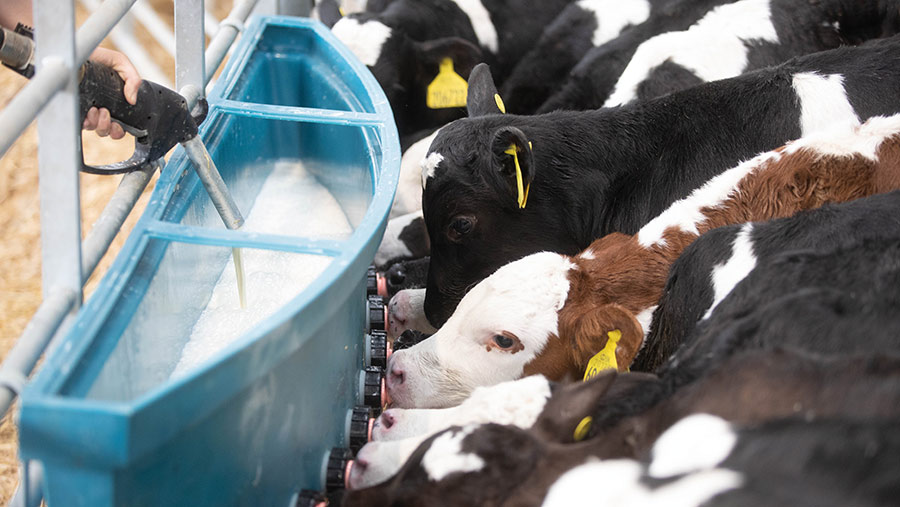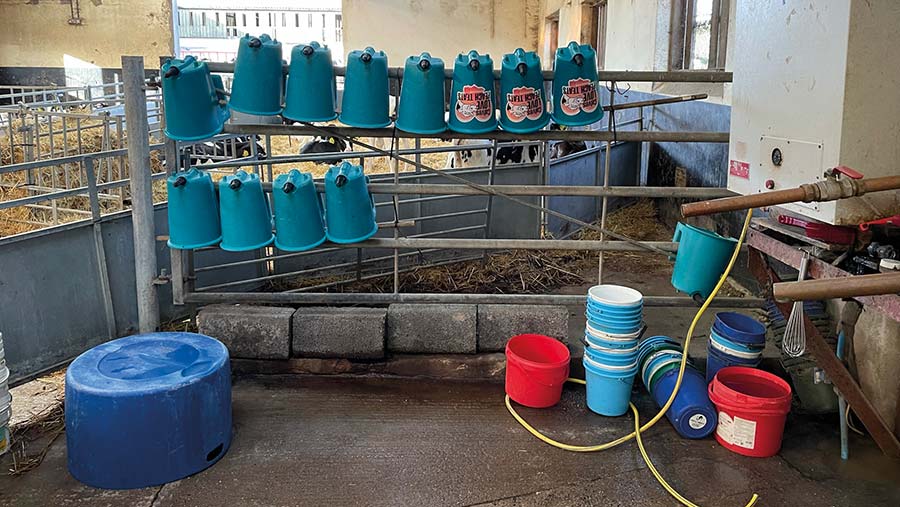4 critical control points to improve calf rearing
 © Tim Scrivener
© Tim Scrivener From birth to joining the adult herd, rearing a dairy calf is estimated to cost an average of £1,800. Therefore, it is essential to get the process right.
Ruminant veterinarian Becca Cavill says there are four control points for the neonatal calf: the calving pen, colostrum management, hygiene and vigilance.
Attention to detail is required on each control point to get the calf off to the best possible start.
See also: How to prevent and treat common problems at calving
Below, Dr Cavil shares her advice and we find out how a Somerset dairy unit has reduced calf mortality from 10% to 2.5%.
1. The calving pen
The environment a calf is born into can significantly affect the first few weeks of life and beyond. In the worst-case scenario, a poor calving setup can lead to increased cases of calf mortality.
Top tips:
- Fully clean out the pen at least every three weeks
- Use it strictly for calving
- Thoroughly clean it between calvings
- Remove gross contamination and bed it up at least once a day
- Ensure the location is somewhere that can be checked frequently
- Ensure there are adequate handling facilities in place.
2. Colostrum management
Colostrum is essential for good growth and providing immunity to newborn calves.
However, 2016 research by the Welsh Youngstock Project showed that only 52% of heifer calves studied had adequate colostral transfer of antibodies.
Top tips:
- Measure intake and quality to ensure calves are getting enough good colostrum
- Consider freezing any excess from Johne’s-negative cows
- Keep feeding equipment and milk preparation areas as clean as you would your own kitchen.
3. Hygiene
As calves are born with no immunity, good hygiene is essential in calf rearing. This encompasses both the environment and equipment.
Top tips:
- When cleaning pens, remove all organic matter and power wash – using detergent where necessary
- Apply a disinfectant – ensuring you use a product that kills all pathogens, including cryptosporidium
- Use a low-pressure spray for a final washdown
- Allow washed items/areas to dry thoroughly
- Establish a foot barrier between dirty and cleaned areas to avoid cross-contamination
- Aside from cleaning, it is important from a hygiene perspective to consider any issues with temperature changes, draughts and damp bedding, all of which can make the calf more vulnerable to infection.
4. Vigilance
Vigilance is vital so that any issues with calves can be identified and put right.
Top tips
- Ensure all staff are adequately trained or experienced to pick up any problems early
- Have a robust protocol in place to quickly and efficiently deal with any health issues
- Monitor and observe calves frequently, noting any changes in colostrum intake, temperature, demeanour and faecal consistency
- Keep a specific eye on bedding, air, water and feed quality as they can all significantly affect calf health.
Case study: Ross Edwards, Manor Farm, Somerset

© Becca Cavill
An 800-head, year-round calving dairy unit in Somerset has reduced calf mortality from 10% to 2.5% by making changes to calving protocols.
About 18 months ago, farm manager Ross Edwards began experiencing some significant issues with calf health, including severe scouring at about seven days of age, pneumonia at four weeks, and a high rate of calf mortality between birth and 42 days of age – with mortality peaking at 10%.
So, he set about making changes in conjunction with his vet, Becca Cavill, focusing on the four critical control points.
Under the previous system:
- Heifers at Manor Farm calved down at 23 months
- Calves were born in a straw yard
- The parlour and calving shed were a long way from the calving area
- Once in the shed, calves were given 3-4 litres of colostrum.
Calving pen changes
Cows calving in the straw yard was considered a key issue in poor calf health and performance.
Though the straw was dry, Mr Edwards said they struggled to get rid of the volume of muck with such a large throughput of cows and calves in the area.
To overcome this, he now aims for a full cleanout of the calving environment every three weeks, reducing to every two weeks during a busy calving period.
“The stone base means disinfecting is difficult, but we do apply lime to keep things clean,” explains Mr Edwards.
The straw yard is now also reserved only for close-up cows that are due to calve within five days of entering the yard.
While this system requires more vigilance of the transition cows, the benefits are worth it, he says.
A specific pen for cows in active labour has also been set up and is bedded with sand, with the aim of providing a cleaner environment than straw for the newborn calf.
Colostrum changes
Four litres of colostrum are now given as soon as possible, ideally within two hours after birth, and fed via a bag and tube to ensure quantity and correct timing of the first feed.
A second feed of an additional two litres a calf is also given.
Colostrum is harvested in the parlour to optimise milk hygiene and fed fresh or frozen in 4-litre bags to preserve quality.
This quality is now also measured using a Brix refractometer, and if it is less than 20%, it is topped up with high-quality colostrum powder.
Any colostrum measuring at more than 24% is prioritised for dairy heifers.

© Becca Cavill
Hygiene changes
Cleaning regimes of feeding equipment have undergone a change too.
Most significantly, buckets are now hung upside down on a makeshift rack – made of two broom handles tied together – to ensure they are completely dry before using again.
After having issues with mould forming in calf bags after cleaning, they are now frozen once cleaned to prevent bacteria growing.
Mr Edwards also uses different coloured teats for morning and evening feeding so that it is obvious to staff whether teats have been changed and cleaned.
Separate tubes are also used for bagging newborns and sick calves.
Calf management changes
With nine staff, Mr Edwards says sharing out responsibility, and communication between the team, are vital for ensuring smooth protocols during calf rearing.
“If we’re not happy with a calf, for example, we’ll put something on the gate so that anyone walking past will know that calf might be sick.
“If someone isn’t in the next day, this means the person picking up their work the next morning will know to keep an eye on that calf,” he explains.
Sometimes calf rearing can be quite demoralising, he adds, particularly when animals are sick, so ensuring there is support for all team members and reassuring staff that they are doing a good job are also key.
Dr Becca Cavill and Ross Edwards were speaking at the National Youngstock Event at Harper Adams University
